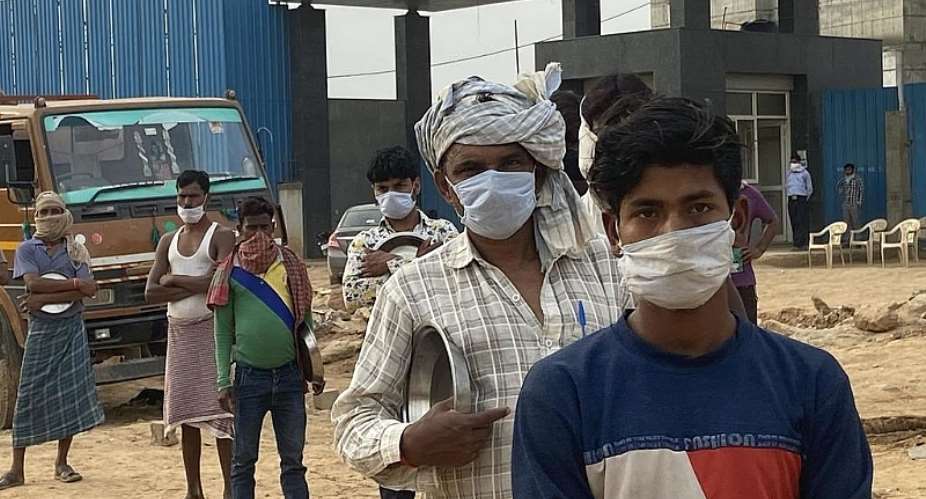Prime Minister's video conference with chief ministers spelt out an exit strategy from the 40-day lockdown. States with increasing cases are likely to see a stricter lockdown post 3 May.
A week before the scheduled end of the lockdown that ends 3 May, Prime Minister Narendra Modi on Monday spoke to chief ministers on an exit strategy and to draw up a plan by marking districts as red, orange and green to indicate the level and intensity of the Covid-19 infection.
This is Modi's fourth interaction with the chief ministers since the lockdown was imposed on 25 March.
Lockdown will stay in red zones
The number of Covid-19-affected districts across the country had increased to 429 on Sunday from 377 districts — 170 hotspots and 207 with fewer cases — listed by the health ministry.
“There is no need to worry on the economy front, our economy is good," Modi said, emphasizing that the lockdown had saved thousands of lives in the past one and a half months.
"The danger of Covid-19 is far from over and hence constant vigilance is of paramount importance," he added.
In his address, Modi underlined the key challenge India was facing - that of balancing lives and livelihood. With economic activity coming to a halt, workers in the informal sector face a bleak future and millions of jobs are on the line in the organised sector.
Meanwhile, India's front line health care staff are fighting the battle to slow the rate of the disease.
A majority of the 28 states and 8 union territories that have a number of Covid-free districts, reportedly want some restrictions to be eased to resume economic activity.
The manner of restrictions and modalities of the lockdown in green zones would be announced before the second phase of the lockdown ends.
There was, however, near unanimity among chief ministers on restrictions on inter-state transportation as well as air and railway transport, indicating that a travel ban would continue post 3 May.
“We should look towards easing people's life by turning the situation to normal. Economic revival is key to moving forward,” said Uttarakhand's chief minister Trivendra Singh Rawat.
Exit but cautiously
Odisha's Chief Minister Naveen Patnaik said he is in favour of continuing the lockdown, but said that it is important that economic activities should be allowed.
“I sincerely urge the Union government to initiate measures to kickstart [the] economy as we work together to curb the disease,” said Patnaik.
Pointing out that India's population was comparable to that of the combined population of several countries, Modi said that the country could protect its people because of the timely measures taken.
Health authorities and communities believe that they can keep the virus at bay through standard public health measures — testing, isolation, quarantine and physical distancing.
“What we have managed in the lockdown has helped the country build and organise a network of isolation centers, hospitals and critical care facilities for Covid-19 patients,” Pratap Raghav, a community health expert told RFI.
The meeting with chief ministers came on a day after the country registered the highest daily increase of 1,945 cases, taking the total number of positive cases to 26,917. The number of deaths touched 826.
The government has projected the country to record 65,000 Covid 19 cases by 15 May.





 Akufo-Addo commissions Phase II of Kaleo solar power plant
Akufo-Addo commissions Phase II of Kaleo solar power plant
 NDC panics over Bawumia’s visit to Pope Francis
NDC panics over Bawumia’s visit to Pope Francis
 EC blasts Mahama over “false” claims on recruitment of Returning Officers
EC blasts Mahama over “false” claims on recruitment of Returning Officers
 Lands Minister gives ultimatum to Future Global Resources to revamp Prestea/Bogo...
Lands Minister gives ultimatum to Future Global Resources to revamp Prestea/Bogo...
 Wa Naa appeals to Akufo-Addo to audit state lands in Wa
Wa Naa appeals to Akufo-Addo to audit state lands in Wa
 Prof Opoku-Agyemang misunderstood Bawumia’s ‘driver mate’ analogy – Miracles Abo...
Prof Opoku-Agyemang misunderstood Bawumia’s ‘driver mate’ analogy – Miracles Abo...
 EU confident Ghana will not sign Anti-LGBTQI Bill
EU confident Ghana will not sign Anti-LGBTQI Bill
 Suspend implementation of Planting for Food and Jobs for 2024 - Stakeholders
Suspend implementation of Planting for Food and Jobs for 2024 - Stakeholders
 Tema West Municipal Assembly gets Ghana's First Female Aircraft Marshaller as ne...
Tema West Municipal Assembly gets Ghana's First Female Aircraft Marshaller as ne...
 Dumsor is affecting us double, release timetable – Disability Federation to ECG
Dumsor is affecting us double, release timetable – Disability Federation to ECG
